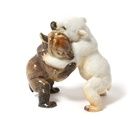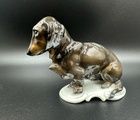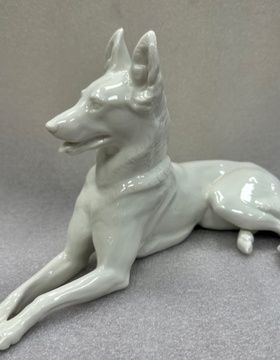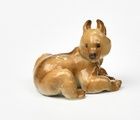Theodor Karner Theodor Karner [10.1.1884 Хоенберг — 6.9.1966, Мюнхен]
Теодор Кернер (Theodor Kärner) / [10.1.1884 Хоенберг — 6.9.1966, Мюнхен]
![Theodor Karner Theodor Karner [10.1.1884 Хоенберг — 6.9.1966, Мюнхен]](/public/media/cache/9c/40/9c404aaf1cbc0ff12ad470e66dfd9f04.jpg)
Теодор Кернер (Theodor Kärner) / [10.1.1884 Хоенберг — 6.9.1966, Мюнхен]
В начале этой статьи мне хотелось бы отметить то счастливое для скульптора обстоятельство, что род его происходил из старой «фарфоровой династии». Теодор Кернер родился в Баварии 10 января 1884 года в маленьком городе Hohenberg der Eger (Хоенберг на реке Егер). Его отец работал на фарфоровой фабрике Hutschenreuther (Хутченройтер), основанной ещё в 1814 году художником Карлом Магнусом Хутченройтером. Заложенное с самого детства трепетное отношение к художественному ремеслу в высшей степени благоприятно отразилось на всём творчестве Кернера. Уже ребенком будущий скульптор проявил особенный талант рисовальщика. В 1898–1903 годах он учится профессии модельщика на фабрике Хутченройтер, а в 1906 году вся семья Кернера переезжает в Мюнхен.
Самым знаменитым представителем стиля нео-барокко в Мюнхене в начале 20 века считался скульптор Вильгельм фон Рюманн (Wilhelm von Rümann, 1850–1906), с 1887 года профессор скульптуры мюнхенской Академии, которого очень высоко ценил правящий принц-регент Баварии. В стилистической противоположности ему был «художественный отец» Мюнхена, Адольф фон Гильдебранд (Adolf von Hildebrand, 1847–1921), который не признавал иного стиля, кроме позднего классицизма. Нео-барочный стиль работ Кернера сформировался в годы обучения в Баварской школе прикладного искусства Мюнхена. Он посещает классы скульптуры профессора Генриха Вадере (Heinrich Waderé, 1865–1950) и профессора Антона Пруски (Anton Pruska, 1846–1930), который преподавал декоративную скульптуру (в том числе анималистику) и орнамент. Затем Кернер как вольнослушатель посещает мюнхенскую Академию искусств.
 |  |  | 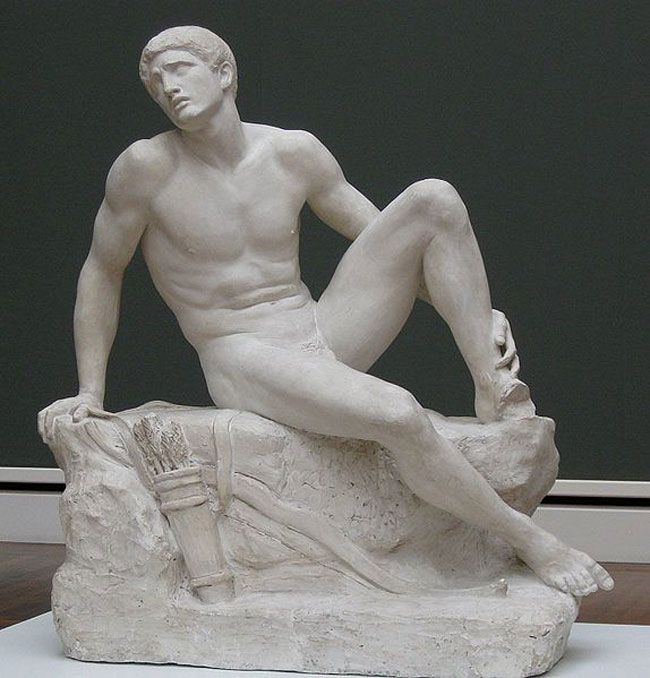 |
| Вильгельм фон Рюманн | Фрагмент памятника кайзеру Вильгельму, Рюманн, 1893 год | Адольф фон Гильдебранд | Фигура Филоклета, Гильдебранд, 1886 год |
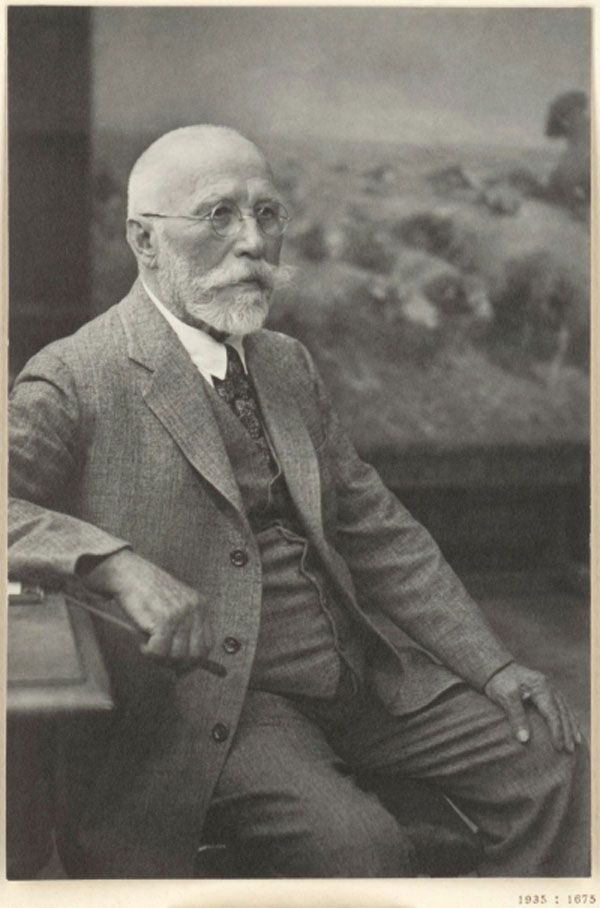
Главным учителем Теодора Кернера был знаменитый немецкий анималист Генрих фон Зюгель (Heinrich von Zügel, 1850–1941), который руководил двумя классами в Академии – для художников и для скульпторов. О неустанном желании продолжать учиться, к тому времени уже много лет работающего «в профессии» скульптора Кернера, говорит тот факт, что позднее он поступил на вечерние курсы академии в 1918–1921 годах. Трудолюбие и талант вызывали у преподавателей чувство большого к нему уважения. И уже после 2-х семестров обучения ему было позволено иметь отдельную мастерскую. По его собственному признанию, Кернер провел в общей сложности 14 семестров в Академии, в 1914–1915 годах и 1920–1921 годах.
Но вернемся в 1905 год. Только что закончивший обучение и никому не известный Теодор Кернер получает предложение от директора фарфорового завода Nymphenburg(Нимфенбург) сделать скульптуру для весенней ярмарки и в случае успеха – место скульптора на фабрике. Когда скульптура «лесная куница», выполненная в натуральную величину, принесла неожиданный успех заводу на Лейпцигской весенней ярмарке, Альберт Боймль (Albert Bäuml), директор завода, выполнил своё обещание: 15 апреля 1905 года скульптор получил место на фабрике Нимфенбург.

В студенческие годы баварская столица стала ему второй родиной. До 1930 года он живёт сначала у родственников на Ferdinand-Maria Straße Nr. 211. Мастерская находилась в это время на вилле доктора Зольнера, в том же районе, на Malsenstraße Nr. 43. Позже скульптор переезжает на Schluderstraße, где квартира и мастерская были объединены вместе, и живёт там с конца войны и до самой смерти. Ему неоднократно предлагали место профессора в Мюнхенской Академии, но Кернер всякий раз отказывался. 20 Апреля 1938 года 54-летний Теодор Кернер получил звание профессора, скорее всего по соображениям политическим. В Мюнхене у него много близких по духу и интересам друзей: Лутц Хек (Lutz Heck), известный зоолог и директор мюнхенского зоопарка, доктор Адальберт Зольнер (Adalbert Zöllner) – начальник одного из отделений филиала Rosenthal в Мюнхене и художник Франц Ксавер Шталь (Franz Xaver Stahl, 1901–1977).
В этой связи надо отметить ещё одного скульптора, который был младше Кернера на один год, художника и рисовальщика Вильгельма Нойхаузера (Wilhelm Neuhäuser, 1885–1960). Он был дружен с Кернером ещё с той поры, когда они посещали сначала Баварскую школу прикладного искусства и позже вместе Академию. Затем они были учениками профессора Генриха фон Зюгеля. Как и Кернер Нойхаузер был штатным сотрудником фарфорового завода Нимфенбург. Для него он создал между 1911 и 1912 годами 16 «звериных скульптур».
![Павлин, Теодор Кернер, [Нимфенбург, 1906]](/public/media/st/002/peacock-Karner-1906.jpg)
![Серая сова, Теодор Кернер, [Нимфенбург, 1905]](/public/media/st/002/barn-owl-karner-1905.jpg) Более чем 40 сантиметровая в длину фигура павлина, которую скульптор Теодор Кернер создал в возрасте 21 года, сегодня считается одной из наиболее известных и выдающихся фигур фарфорового завода Нимфенбург.
Более чем 40 сантиметровая в длину фигура павлина, которую скульптор Теодор Кернер создал в возрасте 21 года, сегодня считается одной из наиболее известных и выдающихся фигур фарфорового завода Нимфенбург.
Элегантная форма птицы подчеркнута искусной подглазурной живописью, техника нанесения которой была доведена до совершенства ещё в начале 20 века. В этой технике краска наносится кистью или аэрографом сразу же после первого обжига, но до того как скульптура погружается в глазурь. После обжига, слои определенного цвета получаются прозрачными и смешиваясь друг с другом образуют тонкие цветовые градации. Богатство оттенков в оперении павлина – характерный результат этого метода живописи.
![Японский хин, Теодор Кернер, [Нимфенбург, 1912]](/public/media/st/002/jap-chin-dog-Karner-1912.jpg) В 1917 году на фабрике Нимфенбург планировался выпуск одной необычной модели вне серийного выпуска. Это должна была быть фигура большого орла, сидящего с распростёртыми крыльями на постаменте, который был декорирован дубовыми листьями – символом воинской чести и доблести. Над заказом работал Теодор Кернер и скорее всего это был специальный заказ, так как был довольно затратен для сравнительно небольшого производства и вряд ли исходил от самой фабрики.
В 1917 году на фабрике Нимфенбург планировался выпуск одной необычной модели вне серийного выпуска. Это должна была быть фигура большого орла, сидящего с распростёртыми крыльями на постаменте, который был декорирован дубовыми листьями – символом воинской чести и доблести. Над заказом работал Теодор Кернер и скорее всего это был специальный заказ, так как был довольно затратен для сравнительно небольшого производства и вряд ли исходил от самой фабрики.
С другой стороны, несколько странно делать скульптуру как «знак победы» во время уже почти проигранной войны…. Так как орёл как геральдический символ чужд Баварии, можно предположить, что орёл должен был выглядеть как «имперский». Как бы то ни было: от модели Кернера сохранилась лишь незаконченная, но подписанная и датированная 1918 годом модель. Она хранится в архиве фабрики.

Otto Pelka, Keramik der Neuzeit, Leipzig 1924
Не подлежит сомнению, что особенный «стиль Нинфенбурга» в изображении животных в основном сформировался благодаря работам Теодора Кернера. Стиль этот был замечен и соответствующим образом оценён современниками.
Превосходный специалист по фарфору доктор Отто Пелька (Otto Pelka) в появившейся в 1924 году книге Keramik der Neuzeit («Керамика современности») писал: «…цвет и форма совершенны. Животные и природа вправе быть востребованными и в искусстве. Чуткое взвешивание всех требований важны для искусства Кернера. И если оценивать его богатый творческий путь, то станет ясно, что он сумел блестяще смягчить натурализм формы до той степени, когда он не нарушает общего художественного восприятия».
Теодор Кернер создал в период с 1905 по 1918 год для фабрики Нимфенбурга 88 моделей. Если представить себе, что между 1905–1921 годами на Нимфенбурге в целом было выпущено 155 скульптурных моделей, то вклад именно Теодора Кернера в развитие завода смело можно считать наиболее значительным.
![Лежащая пума, Теодор Кернер, [Нимфенбург, 1918]](/public/media/st/002/liegender-silberlowe-560.jpg) Прежде чем закончить главу «Нимфенбург» в жизни Кернера, я хотел бы особо отметить ряд фактов, которые собственно и поставили точку на этом периоде его жизни. Как штатный сотрудник мануфактуры он получал в течение нескольких лет перед Первой мировой войной в высшей степени скромный месячный заработок в размере 120 золотых марок. К примеру, зарплата молодого учителя в народной школе была 100 марок. По причине «низкой заработной платы, унижающей его как художника» Кернер заявил о своём уходе в 1918 году, на что Альберт Боймль, директор фабрики, покровительственно заметил, что Кернер наверняка нигде не найдёт другую постоянную работу как скульптор-анималист.
Прежде чем закончить главу «Нимфенбург» в жизни Кернера, я хотел бы особо отметить ряд фактов, которые собственно и поставили точку на этом периоде его жизни. Как штатный сотрудник мануфактуры он получал в течение нескольких лет перед Первой мировой войной в высшей степени скромный месячный заработок в размере 120 золотых марок. К примеру, зарплата молодого учителя в народной школе была 100 марок. По причине «низкой заработной платы, унижающей его как художника» Кернер заявил о своём уходе в 1918 году, на что Альберт Боймль, директор фабрики, покровительственно заметил, что Кернер наверняка нигде не найдёт другую постоянную работу как скульптор-анималист.Когда же Боймль понял, что зашёл слишком далеко и намерение Кернера уйти с фабрики серьёзно, он обещал увеличить его оклад втрое. Тем не менее, Кернер настаивал на немедленном окончании его контракта с фабрикой. Далее произошло неприятное, но вполне объяснимое – директор, который понимал, очевидно, очень мало в искусстве, но в коммерческих вещах разбирался прекрасно, обвинил скульптора в том, что он якобы потребовал с заказчика для одной своей модели двойную плату. В этой истории, естественно, все обвинения против Кернера были выдуманы, с тем чтобы вообще не заплатить скульптору положенного гонорара. Речь идёт о выполненной им в 1918 году скульптуре лежащей пумы (модельный номер 560).
Полученное оскорбление художник не забыл до конца жизни. К счастью, скоро в его карьере произошли значительные и благоприятные изменения…
Аукцион искусства и старины art-picture.ru предоставляет возможность покупки
приобрести представленны лоты по теме "Theodor Karner Theodor Karner [10.1.1884 Хоенберг — 6.9.1966, Мюнхен]"

